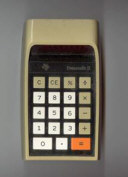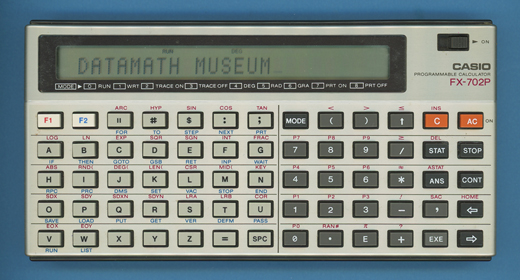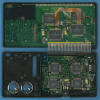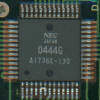
DATAMATH CALCULATOR MUSEUM
 |
DATAMATH CALCULATOR MUSEUM |
CASIO FX-702P
| Date of introduction: | November 1981 | Display technology: | LCD |
| New price: | $249.00 (MSRP 1981) | Display size: | 20 Alpha + 2 Numeric |
| Size: | 3.2" x 6.5" x
0.70" 82 x 165 x 18 mm3 |
||
| Weight: | 6.3ounces, 179 grams | Serial No: | 1B209A |
| Batteries: | 2*CR2032 | Date of manufacture: | mth 01 year 1982 |
| AC-Adapter: | Origin of manufacture: | Japan | |
| Precision: | 12 | Integrated circuits: | CPU: HD43190A02, HD43190A03 RAM: 4*uPD444G DISP.: HD43191A02, HD43191A03 |
| Memories: | 26-226 | ||
| Program steps: | 1.680-80 | Courtesy of: | Joerg Woerner |

![]()
 Sharp
Corporation introduced in June 1980 with the PC-1210 (and its sibling
PC-1211) the World's first Pocket Computer with BASIC programmability.
It took only about three months and Matsushita defined with their
Panasonic HHC a new category of
Hand-held Computers or Portable Computers. Main competitor in Japan, Casio
Computer Co., Ltd, on the other hand introduced with the
FX-501P
and FX-502P in October 1979 their first keystroke Programmable Pocket
Calculator with LC-Display, succeeded in March 1981 with the FX-601P and
FX-602P, introducing a dot matrix LC-Display and laying the foundation for the
FX-702P "Pocket Computer". Casio took a different approach than Sharp and added
BASIC programmability to a Scientific Calculator and labeled the device with
"Programmable Calculator" accordingly. Casio's early advertisement featuring the
FX-702P used often a big headline "More Power To Your Pocket" to challenge rival Sharp.
Sharp
Corporation introduced in June 1980 with the PC-1210 (and its sibling
PC-1211) the World's first Pocket Computer with BASIC programmability.
It took only about three months and Matsushita defined with their
Panasonic HHC a new category of
Hand-held Computers or Portable Computers. Main competitor in Japan, Casio
Computer Co., Ltd, on the other hand introduced with the
FX-501P
and FX-502P in October 1979 their first keystroke Programmable Pocket
Calculator with LC-Display, succeeded in March 1981 with the FX-601P and
FX-602P, introducing a dot matrix LC-Display and laying the foundation for the
FX-702P "Pocket Computer". Casio took a different approach than Sharp and added
BASIC programmability to a Scientific Calculator and labeled the device with
"Programmable Calculator" accordingly. Casio's early advertisement featuring the
FX-702P used often a big headline "More Power To Your Pocket" to challenge rival Sharp.
With the three cornerstones of the emerging market defined, Sharp consequently split their portfolio for the successors of the PC-1201/PC-1211 into two different directions:
| •
PC-1500 (1982): Portable Computer as a center of a Computer System with many peripherals • PC-1401 (1983): Hybrid of a Pocket Computer with BASIC Programmability and a Scientific Calculator |

 The FX-702P Programmable
Calculators features not only an internal expansion slot for a memory cartridge
but a 7-pin connector for peripherals on its left side:
The FX-702P Programmable
Calculators features not only an internal expansion slot for a memory cartridge
but a 7-pin connector for peripherals on its left side:
| Product | Description | MSRP (1981) |
| FA-2 | Cassette Interface (Fits FX-501P/FX-502P/FX-601P/FX-602P, too) |
$49.00 |
| FP-10 | Mini Printer, electro-sensitive FP-36 paper, up to
20 characters per line, 2 lines per second (Fits FX-601P/FX-602P, too) |
$109.00 |
| (not released) | 4k Bytes RAM module with backup battery | |
| (not released) | 8k Bytes RAM module with backup battery |
 Dismantling the featured Casio FX-702P manufactured in
January 1982 by Casio Computers in Japan reveals a complex design based on two printed circuit boards (PCBs)
in a clamshell packaging. The larger of the two PCBs is populated
with two 4-bit microcontrollers and two Integrated Circuits (ICs) to drive the
alphanumeric LC-Display. The smaller of the two PCBs holds four RAM
(Random-access Memory) chips.
Dismantling the featured Casio FX-702P manufactured in
January 1982 by Casio Computers in Japan reveals a complex design based on two printed circuit boards (PCBs)
in a clamshell packaging. The larger of the two PCBs is populated
with two 4-bit microcontrollers and two Integrated Circuits (ICs) to drive the
alphanumeric LC-Display. The smaller of the two PCBs holds four RAM
(Random-access Memory) chips.


 The two PCBs of the FX-702P Pocket Computer hold an impressive
list of ICs and Casio proved again the leadership of Japanese companies in
miniaturization:
The two PCBs of the FX-702P Pocket Computer hold an impressive
list of ICs and Casio proved again the leadership of Japanese companies in
miniaturization:
| • HD43190A02: 4-bit
microcontroller with integrated RAM and ROM and display driver for 8
rows manufactured by Hitachi in a CMOS process and using an 80-pin QFP (Quad Flat Pack) package • HD43190A03: 4-bit microcontroller with integrated RAM and ROM manufactured by Hitachi in a CMOS process and using an 80-pin QFP (Quad Flat Pack) package • 4*PD444G: 512*4 Bits RAM manufactured by NEC in a CMOS process and using a 52-pin QFP (Quad Flat Pack) package • HD43191A02: Display driver for 54 columns with built in RAM, manufactured by Hitachi in a CMOS process and using an 80-pin QFP (Quad Flat Pack) package • HD43191A03: Display driver for 54 columns with built in RAM, manufactured by Hitachi in a CMOS process and using an 80-pin QFP (Quad Flat Pack) package |
Comparing the ICs of a FX-702P BASIC Programmable Calculator with the chips of a FX-602P keystroke Programmable Calculators unveils an unexpected similarity:
| • FX-602P: HD43190A01, HD43191A01, 1*uPD444G • FX-702P: HD43190A02, D43190A03, HD43191A02, HD43191A03, 4*uPD444G |
If you have additions to the above article please email: joerg@datamath.org.
© Joerg Woerner, January 5, 2021. No reprints without written permission.